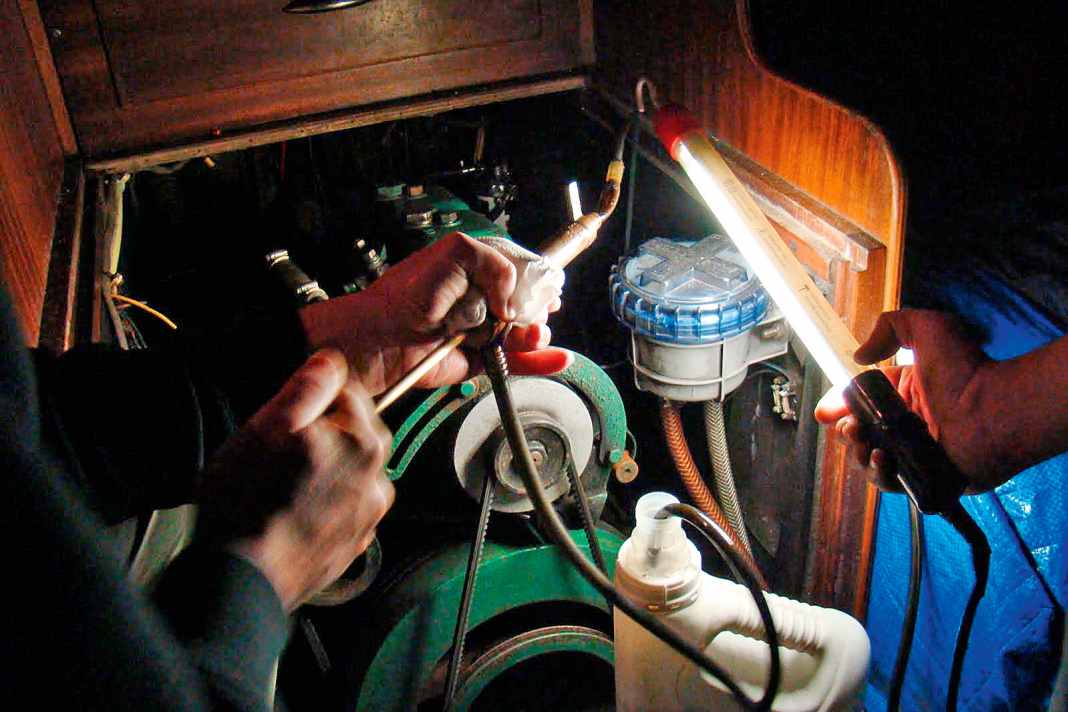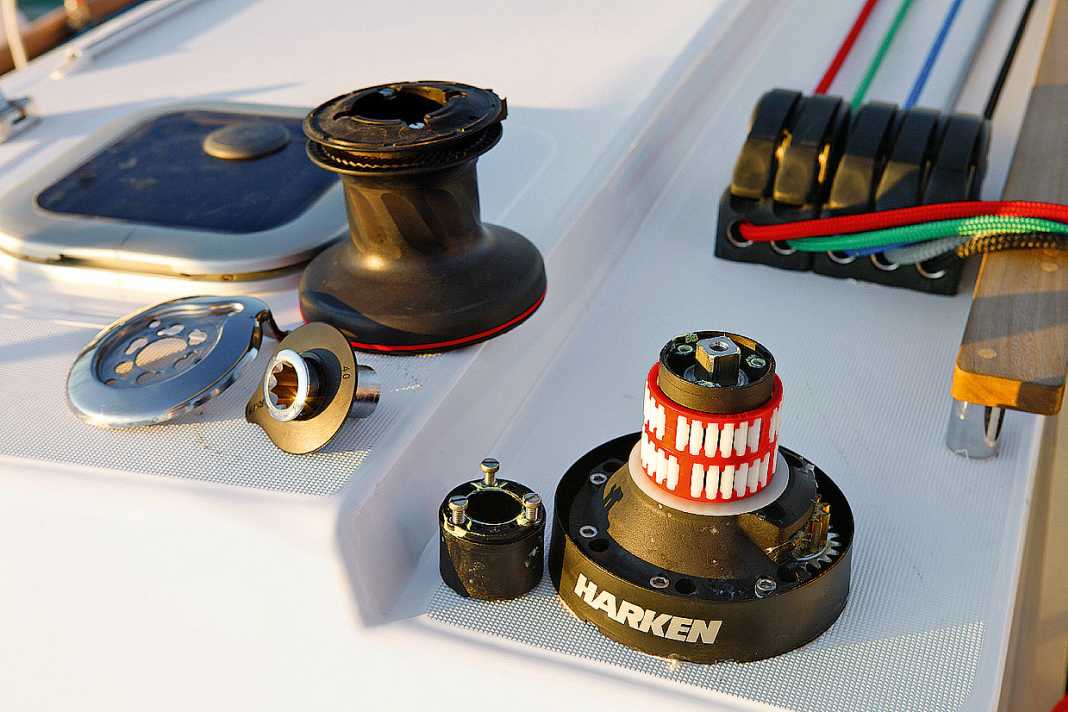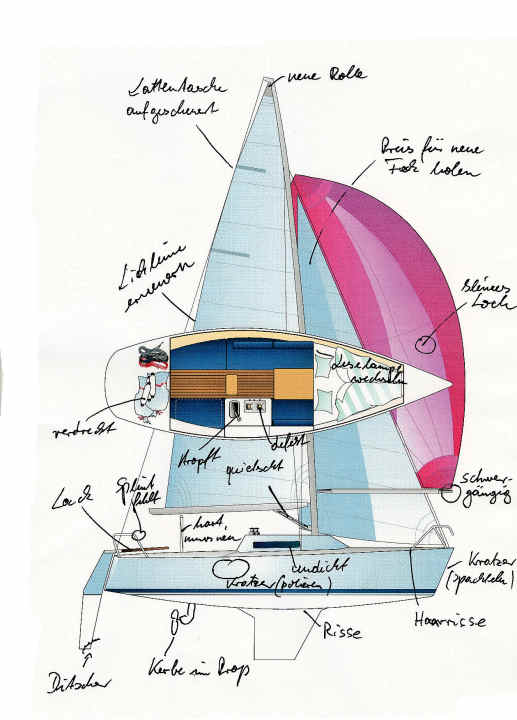Winterising a sailing boat: The most important tips for the end of the season

In this article:
The season is coming to an end, the dark days are coming and so is winter storage. Anyone who has been sailing their boat for a long time will be more relaxed about the work. However, if the owner is less experienced or has not owned the boat for very long, then a few questions are sure to arise on the day of uncraning: Is it better to winterise the engine in the water or on land? When should I change the oil? Should I polish the boat in the autumn or in the spring? And what was the order of the winterisation work?
For this reason, we have listed the most sensible procedures for you, starting with the oil change through to antifouling painting in the spring. In addition to the annual maintenance and repair work, winterising is primarily about protecting the boat from the effects of winter. On the one hand from rain and snow - for example by storing it indoors or using a tarpaulin - and on the other hand from cold, frost and humidity.
However, putting the yacht ashore in winter is not absolutely necessary, but rather a German phenomenon. Most GRP boats are perfectly suitable for winter storage, even in ice, as our neighbours in Holland prove. Thousands of yachts stay in their element there every year. However, it should be a calm body of water and precautions must be taken.
Work for the autumn






Work for the spring





Winter storage without worries
There is no doubt, however, that the owner will sleep more soundly if the yacht is jacked up and preserved in a dry shed while the winter storms sweep around the house outside. However, to ensure that he doesn't realise too late - possibly under the Christmas tree - that he has neglected an important detail of winterisation, it is helpful to draw up a plan beforehand in which all the points in question are listed. Our diagram above can serve as a guide. Individual points will be handled differently depending on the ship.
To keep track of the tasks and costs, a drawing should also be made of the work that needs to be done in winter. It makes sense to number the steps in logical order - for example, to avoid realising after the teak has been oiled that some joints should have been repaired first.
Some tasks should be completed in the autumn. For example, the engine check, so that the replacement of engine foundations or similar can be added to the to-do list straight away. Other, smaller jobs are more suitable for the spring, such as servicing winches or replacing sacrificial anodes.

Winterising the machine
In most cases, winterisation begins with an oil change. To do this, the engine should be warmed up - because warm oil is less viscous than cold oil and can therefore be pumped out more easily. When winterising the engine, a distinction must be made between dual-circuit cooling and old-fashioned single-circuit cooling.
While with dual-circuit cooling it is usually sufficient to empty the water inlet and check the antifreeze in the expansion tank and top it up if necessary, with single-circuit cooling the entire cooling circuit must be flushed with antifreeze. This can be done either by adding antifreeze to the system via the sea water filter until it emerges from the exhaust and is collected - or by using a self-made cooling circuit. The antifreeze is sucked out of a canister via the cooling water intake and fed back into the canister on the other side via the exhaust cooling system. Caution: The exhaust is then no longer cooled - the machine should not run for too long.
To winterise the single-circuit cooled engine, it is also important to bring the machine up to operating temperature beforehand: Only then does the thermostat open, allowing the entire cooling circuit to be supplied with antifreeze during priming.
Polishing - now or later?
If the yacht spends the winter indoors, it should be polished in the autumn for the following season - a task that many owners only tackle in the spring, shortly before launching. "By then, however, the boats are full of dust again and micro-scratches appear in the gelcoat during polishing," says Sven Jürgensen from Maincare, an expert in the field of yacht care. "In autumn, on the other hand, immediately after thoroughly washing the hull, the conditions are ideal." In addition, the temperature is usually still pleasant and the air is less humid. In spring, the night frost regularly cools the boats down, while the sun shining on the hall roofs during the day produces condensation. "The long waiting time doesn't damage the polish," continues Jürgensen, "only salt and sunlight do that. The ship is protected from this in the hall."
However, if the boat spends the winter in outdoor storage, it may actually make sense to polish it in the spring. If the tarpaulin has left scuff marks on the hull, they can be removed in this step. "In any case, the boat should be thoroughly cleaned and degreased before polishing," says Jürgensen. "And you should make sure that the air contains little moisture, otherwise conventional polishes won't stand a chance." The specialised company is better equipped for this and has twelve sanding and high-gloss polishes for all weather conditions. Good lighting is also an advantage. "You see a lot of poorly polished boats coming out of the halls in spring because the owners could barely recognise the gelcoat surface in the dull hall light.
Mould-free through the winter
Before the ship is brought into the hall or wrapped in a tarpaulin, it should be largely cleared out. Of course, all hazardous materials should be removed from the boat, including the gas bottle, the emergency rockets and the spare petrol canister. In addition to last season's supplies, all textile materials should also be removed from the boat, as they often absorb moisture from the air and cause spak to form. Particular attention should be paid to good ventilation. If the walls of the yacht are lined with carpets, it is better to install additional dehumidifiers. Forced ventilation of the cabin should also be ensured by leaving the hatches slightly open to prevent the build-up of humidity.
If you want to cover your boat indoors with a dust tarpaulin, it is better to choose a cotton tarpaulin instead of a plastic one, as this allows much better air exchange. In outdoor storage, the ship should be protected from the weather but also well ventilated. This requires an effective opening at the front and rear of the tarpaulin. In this way, some air constantly passes underneath and condensation is avoided.
Planning for sailing boats: properly considered or unfortunately not planned?
If you want to protect your boat from the weather with a tarpaulin, it must be well dimensioned and securely tensioned so that it can withstand winter storms. If you throw the tarpaulin over the boat without thinking about it, you won't enjoy it for long. Above all, it is important to avoid sharp edges and chafe marks.






Tips and tricks for winterising
We do it again and again - but is it the right thing to do??
Pull a bottle of cheap grain through the water pump instead of special antifreeze?
This method is safe and effective.
Winterising in water with plastic seacocks?
The manufacturers Marelon and Trudesign have been on the market for more than 30 years. Their products can indeed be considered winter-proof.
Simply book the cheapest winter storage (floor space)?
Winter storage companies often try to lure new customers with low prices per square metre. However, the large sums are then hidden in the ancillary costs. Alternatively, the operator prohibits the customer from doing their own work and the owner is reliant on their service.
Does the ship really have to be completely stripped out?
Things that cannot mould or spook stay on board. It doesn't matter whether fenders are stored in a damp garage or in a damp boat. Rule of thumb: paper and textiles must go down.
Is it a good idea to leave the boat connected to shore power while you are away, because then the battery is always well charged?
Although many sailors actually do this, it is better to fully charge the batteries once in autumn and then disconnect them from the mains. After all, an unattended power connection is always a danger.
Does the ship need a tarpaulin when it is in the hall?
Even under a solid roof, it can't hurt to cover the yacht with a flame-retardant dust cover. After all, a lot of dust naturally accumulates on it over the winter.
Does the engine also have to be winterised if the boat remains in the water?
It should always be ready to start in case of problems during the winter. A small, electric frost monitor in the engine compartment protects against damage.
Should sacrificial anodes be changed every year?
As long as they are still in good condition, they do not need to be replaced. It is sufficient to refurbish the surface with sandpaper.

